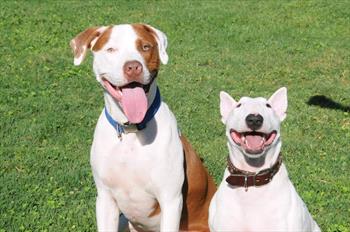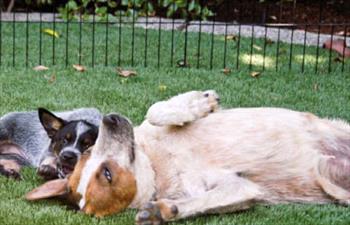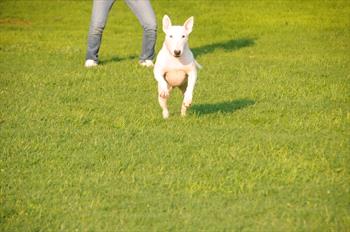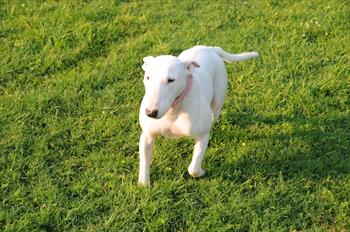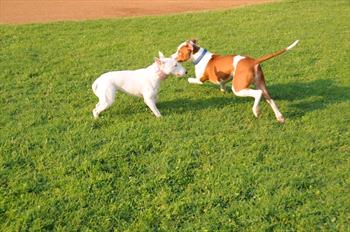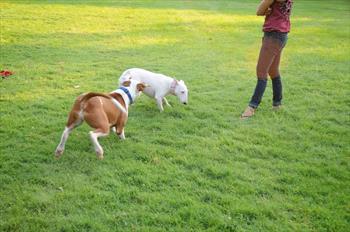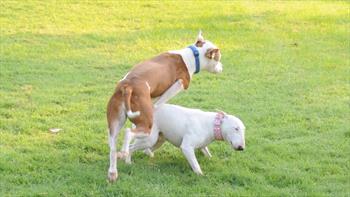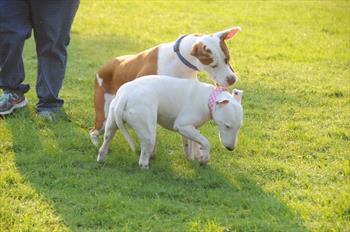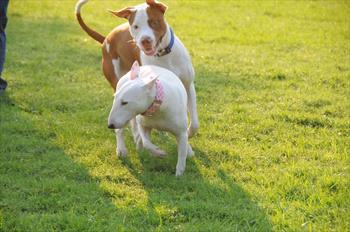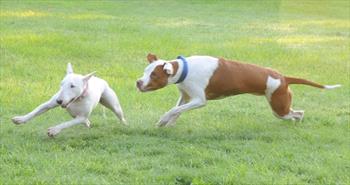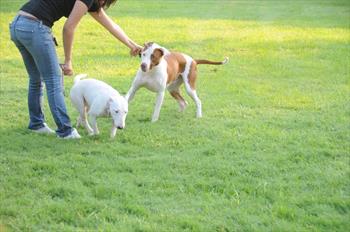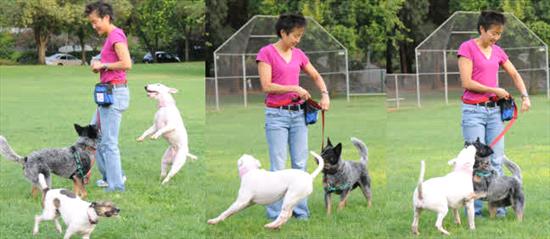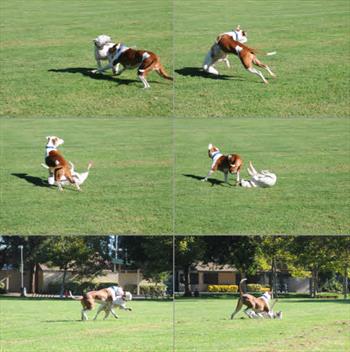It’s fun to take your pooch to the park for off-leash play and dogs can look like they are having fun, but are they always learning the right things?
One owner of a Bulldog knows all to well that the answer is no. “Max took a while to warm up to new people and dogs,” she says. “Then we left him with the breeder where he got to run around with other Bulldogs in what the breeder said was normal rough bulldog play. When we got him back he was suddenly barking and lunging people he would have just stayed away from before and dogs didn’t seem to want to play with him.”
What happened? The same thing that happened to my parent’s Australian Cattle Dog, Lucy, after a few overly rowdy play sessions during puppy class. Before the classes and by about 9 weeks of age, she had already had 5–7 appropriate play sessions with dogs and learned to come when called away from them so we could keep her from irritating other dogs. But after this class, and by 11 weeks of age, she no longer heeded the signals that other dogs gave to stop and when they upped their message, she’d start to fight.
Lucy engaging in fun but appropriate play at 8 weeks of age.
Here are the results of her overly aroused play. You can see when the little dog, Dozer, gets irritated. He suddenly speeds up his interactions in hopes that she will get the message. She doesn’t. Then when he more forcefully tells her to back off, she starts to fight. After this incident, Dozer, who had a great track record with playing other dogs, started becoming more defensive with big dogs running up to him so his owner had to specifically work on training him to feel comfortable with big dogs running up to him.
The problem that has occurred here is that these dogs have engaged in overly aroused play and as a result are developing poor impulse control. And top of the impulse issues, overarousal itself is an issue because overarousal and aggression are on a continuum. In fact that’s one reason why fans at the Superbowl just start out really excited but then so often after their team wins, the arousal leads to a riot.
So how do you know if your dog’s is exhibiting behavior that may put him at risk. Here’s a video of Bonnie the Bull Terrier and Porter the Pitbull and see what you think. The answer is below in the text.
Bonnie the Bull Terrier is super-excited to be at the park. She dragged her owner on leash and is wound up and ready to spring.
When she’s released, she comes bounding into the park.
At first glance, this may look like fun for all; however, some people see this hyper approach and immediately fear for their knees. Similarly, some dogs see a potential trampling threat and react by becoming defensive.
In fact, Bonnie’s demeanor suddenly changes when the tables are turned.
Porter the Pitbull, whom she played with last week, comes rushing in. Note that Bonnie’s tail is down and she’s leaning away. Bonnie’s not a small dog, but Porter is bigger.
And then here she’s cowering for an instant as Porter heads for a crash with her.
Porter hurls himself over her.
And later he comes back to jump on her.
Notice the intense look on Porter’s face.
Bonnie’s just trying to get away.
Now she runs and, for short bursts, she’s playing and having fun. And other times the play is too fast for her and she cowers slightly.
Later, Bonnie’s mom comes to the rescue and holds Porter. Bonnie chooses to stay away, which shows that she thought the play was too rough too.
Overall these two dogs do get along with each other. But their rough behavior can affect their relationship with other dogs and can affect other dogs detrimentally, just the way Lucy’s behavior affected Dozer’s tolerance of other dogs. In fact Chloe barks and lunges at dogs when on walks. That, in turn, trains some of those dogs to defensively learn to bark and lunge back.
For instance earlier in the day Bonnie was acting like Porter around Lucy, whom she has never met before.
While Lucy is comfortable with familiar friends when they play rough, when an unfamiliar dog invades her space and tries to repeatedly jump on her, she becomes anxious (see her lick her lips) and then snaps in warning.
As soon as Bonnie backs off, Lucy sits and focuses on me. She also can heel around the park with Bonnie near her. Bonnie’s keeping a little wider distance instead of jumping on or getting in Lucy’s face. She’s learned to keep back from Lucy. But she may not remember next time or she may test every dog she meets, which can be traumatic for the dogs she rushes.
While Bonnie is a bit rude, she’s good-natured so she backs off. But some highly excited dogs respond to such reprimands by fighting back, often with less impulse control, which often leads to a fight that might just be spit and drool or that may end in a bite. Note that in this situation, Lucy can take care of herself but it’s nor really fair that she has to do so. The more she has to take leadership role in protecting herself the less likely she will turn to humans to help her or provide guidance in these situations. For the purpose of this photo I let her respond this way when I could have easily redirected her attention away from Bonnie, or distracted Bonnie, or asked Bonnie’s owner to hold her.
Like Bonnie, Porter is playful but socially inept. He likes to play but he’s too rough. His saving grace is twofold:
- He gets tired after about 5 minutes and then interacts more calmly.
- So far, when dogs have growled or snapped at him, he’s learned to stop bugging them, rather than getting more aroused and starting a fight.
Their Interaction the Week Before
Here’s Porter with Bonnie the week before. Interestingly, from this interaction, you might think they are perfect playmates.
When Porter’s being held, Bonnie solicits play.
There’s some even exchange of play and Bonnie does not appear to be scared. That is, Porter is not always the chaser.
There are also stops in play where the two calm the situation down.
Although Bonnie never looks scared, the pace is fast for her and she gets bowled over multiple times. This may explain why she showed more reservations to playing with Porter in the follow-up play date.
Take home message:
The take home message here is that not all play is good. Over-arousal can cause dogs to rush around in ways that scare other dogs and the arousal can spill into aggression.
The solution?
Teach your dog a fantastic come when called so you can call him before play gets out of hand. If you do this consistently, then this “come” cue will become a habit and it can even be used to help train good doggie play habits. (see blog on Come When Called).
Here’s Lucy at the park. She can let other dogs play on their own if they don’t want to play with her. She can also leave their toys alone and play with her owner OR take turns playing with Jonesy’s toys (and bringing them back in between).
To see a video of calling a dog away from another dog before trouble starts, watch Jack Russell Terrier Comes When Called.


